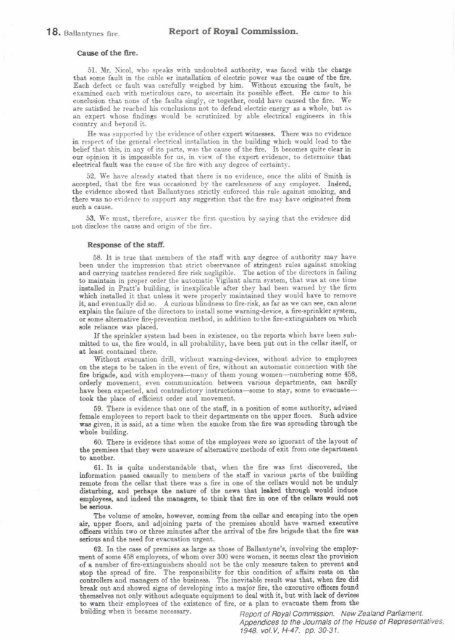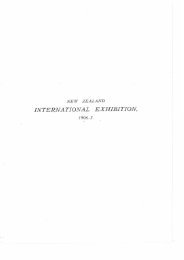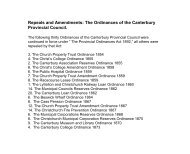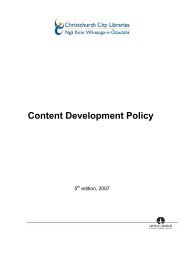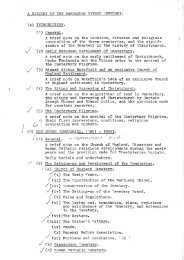Whole Project Resource Pack - Christchurch City Libraries
Whole Project Resource Pack - Christchurch City Libraries
Whole Project Resource Pack - Christchurch City Libraries
You also want an ePaper? Increase the reach of your titles
YUMPU automatically turns print PDFs into web optimized ePapers that Google loves.
Report of Royal Commission.<br />
31. Mr. Nicol, who speaks with undoubted authority, was faced with the charge<br />
that some fault in the cable er instahtion of electric power was the came of the ht.<br />
Each defect or fault was carefully weighed by him. Without excmbg the fault, he<br />
examined each with met.icnlous care, to ascertain its possible effect. He came to his<br />
conclusion that none of the faults singly, or together, could have c a d the fire. We<br />
are satSed he reached his mnclnsiom not to defend electric energy se a whole, but &u<br />
an expert whose hdings would be scrntinized by able electricel engineers in this<br />
country and beyond it.<br />
He was suppotted by the evidence of other expert witneeses. There was no evidence<br />
in respect of the general electrical installation in the building which would lead to the<br />
belief that this, in any of its parts, was the cause of the fire. It becomes quite clear in<br />
om opinion it is impoesible for us, in view of the expert evidence, to determine that<br />
electric'al fault wss the cause of the fire with any degree of certainty.<br />
32. We have already stated that there is no evidence, once the alibi of Smith is<br />
mpted, that the fire was occasioned by the carelessness of any employee. Indeed,<br />
the evidence showed that Ballantpea strictly enforced this rule against smoking, and<br />
there was no evidence to support any suggestion that the fire may have originated from<br />
such a caw.<br />
53. We must, therefore, answer the first question by saying that the evidence did<br />
not disclose the cause and origin of the he.<br />
68. It is true that members of the stoff with any degree of authority may have<br />
been under the impreasion that strict observance of stringent rulea againat smoking<br />
and carrying matches rendered fire risk negligible. The action of the directors in failing<br />
to maintain in proper order the automatic Vigilant alarm system, that was at one time<br />
hlled in Pratt's building, is inexplicable after they had been warned by the firm<br />
which installed it that unlees it were properly maintained they would have to remove<br />
it, and eventually did so. A curious blindneae to fire-riak, aa far as we can see, can alone<br />
explain the failure of the directors to install some warningdevice, a fire-sprinkler sptem,<br />
or some alternative -prevention method, in addition tothe fire-extinguishers on which<br />
sole reliance waa placed.<br />
If the sprinkler system had been in existence, on the reporb which have been submitted<br />
to us, the fire would, in all probability, have been put out in the cellar itself, or<br />
at least contained there.<br />
Without evaouation drill, without warningdevicee, without advice to employees<br />
on the step to be taken in the event of fire, without an automatic connection with the<br />
ht brigade, and with employees-many of them young women-numbezing some 458,<br />
orderly movement, even communic~tion between varioue departments, can hardly<br />
have been expected, and contradictory instmctiowme to stay, some to evacuatetook<br />
the place of efficient order and movement.<br />
59. There is evidence that one of the staff, in a poeition of some authority, advised<br />
female employees to report back to their departments on the upper floors. Such advice<br />
nse given, it is eaid, at a time when the Bmolre from the fire was spreading through the<br />
whole building.<br />
60. There is evidence that some of the employees were so ignorant of the layout of<br />
the premisea that they were unaware of dternative methods of exit from one department<br />
to another.<br />
61. It ie quite mde-ndable that, when the h waa firat dieoovered, the<br />
information paaged manally to members of the eteff in various parts of the building<br />
remote from the cellar that them was a fire in one of the cellara would not be unduly<br />
dinturhg, and perhap t&e p.ture of the n m<br />
that laded through would induce<br />
amplopm, dindeed themmagas, to* that binoneofthecellua would not<br />
ba mu#.<br />
The volume of smoke, however, coming from the osllu and -ping info the open<br />
air,. upper floors, and adjoining parta of the premises should have warned executive<br />
otliaere within two or three minutea after the anid of the fire brigade that the b waa<br />
eerioua and the need for evacuation urgent.<br />
62. In the case of preh as large ae thow of Ballantyne'e, involving the employment<br />
of some 458 employees, of whom over 500 were women, it seema clear the provieion<br />
of a number of<br />
'<br />
era should not be the only measure taken to prevent snd<br />
atop the s p r e a d x e mponsibility for this condition of a&.irs lat. on the<br />
controllere and manegers of the baeineaa. The inevitable result wm that, when fire did<br />
break out and showed eigns of developing into a major fire, the exeoutive offi- found<br />
therrmelvea not only without adequate equipment to deal with it, but with la& of deviotm<br />
.to mun their employee8 of the existence of fire, or a plan to evacunte them hm the<br />
building when it became neceesary. Report of Royal Comrnmssion. New Zealand Padament.<br />
w s to the Journals of the House of Representatives,<br />
1948. w1.V. H-47. pp. 30-31.


